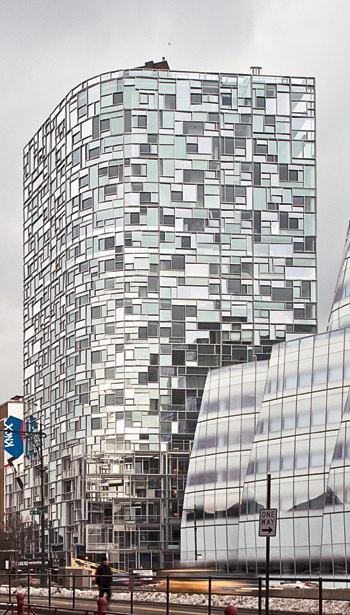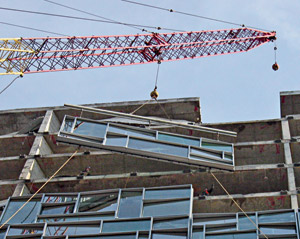Behind the Curtain Wall
100 Eleventh Avenue
 |
The gridded facade of Jean Nouvel's 100 Eleventh Avenue contrasts with Gehry's billowing IA C Building. Photo: © Philippe Ruault |
Just north of One Jackson Square in Chelsea, on a corner lot that sits opposite the billowing IAC Building, Frank Gehry's first building in New York City, Jean Nouvel has created a kaleidoscopic facade with an entirely different character from that of the KPF building.Â
The De Stijl-like composition of the 250-foot-tall, curving curtain wall is a tour de force of glass and metal. According to Nouvel, "The architecture expresses the exceptional pleasure of being at this strategic point of Manhattan."
The open site is on Manhattan's extreme West Side. Many apartments within the building have unobstructed views of the Hudson River. While Nouvel wanted to capture those views as much as possible, along with the changing light, he was not interested in dematerializing the wall. "We wanted the mullions to look strong and create strong frames," says François Leininger, Ateliers Jean Nouvel's project manager. "You can feel the presence of metal."
Facade consultants Front worked with Nouvel's office to create a curtain wall that featured fixed and operable tilting windows of various sizes and shapes - in essence, a random series of folding planes. To give some regularity to the wall, the team - which included curtain-wall fabricators in China - created megapanels, some as large as 12 feet high by 37 feet wide and containing as many as 20 smaller, individual panels. The megapanel joints are the only areas on the facade that have a continuous vertical mullion. The curving section of the facade features a concentration of smaller panels. Several mock-ups were built both in China and the U.S. to evaluate the wall's aesthetic appearance and performance.Â
"There is a huge amount of dimensional variety," says Front's Marc Simmons. "But it is not a mathematically generated facade. It really is hand composed from a very architectural idea. It is a game of fragmentation."
Because of the fragmenting lines, the load path from slab to slab is not continuous. Steel forms the facade's structure since the nonlinear load paths and massive panels would have conspired to make an aluminum structure too large to be attractive inside the apartments. All the 3-inch-wide steel elements sit in the same plane, but vary in depth. The steel frame, which is visible from the apartment interiors, is composed of laser-cut steel plates that were welded together, sandblasted, and painted silver. Interiors feature polished concrete ceilings and terrazzo floors.
 |
A crane lifts one of the curtain wall's megapanels into place during construction of the facade. Photo: Front Inc. |
"The wall was really designed from the inside out," Simmons explains. "A typical floor features seven megapanels, and each megapanel corresponds to a room. In the largest rooms, you have a 37-foot-wide panorama that eradicates all evidence of traditional curtain-wall construction."
Simmons describes this curtain wall as a hybrid, one that combines characteristics of a window wall where individual panels have no structural dependency on adjacent panels. "The fact is, hybrids are becoming much more common because they can achieve certain architectural intentions that could not be achieved by traditional aluminum unitized curtain walls," he explains. "Those are optimized for fabrication efficiencies and ease of transport. The megapanels on this project are so large and heavy that they can't overlap or have interlocking legs. They are independent of each other."
The exterior layer is silver anodized aluminum to match the silver-painted steel on the interior. While not structural, the aluminum holds the low-E glass panels, which are insulated and laminated. Three different glass coatings were selected to provide a variety of colors on the facade. The glass adheres to a strict STC rating required by noise ordinances for buildings along Manhattan's West Side Highway.
Â
We speak with Ateliers Jean Nouvel's project manager, Francois Leininger, and Marc Simmons of facade consultant Front about the two faces of 100 Eleventh Avenue. |









